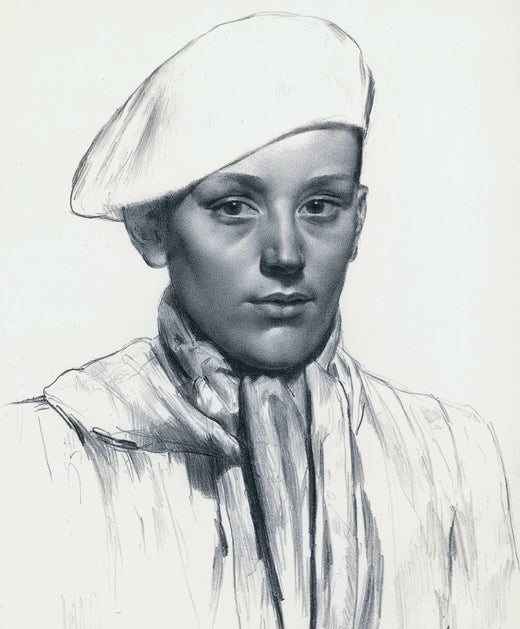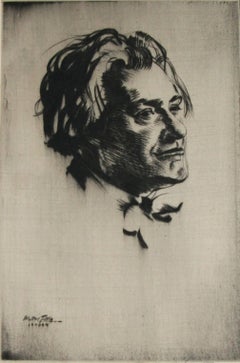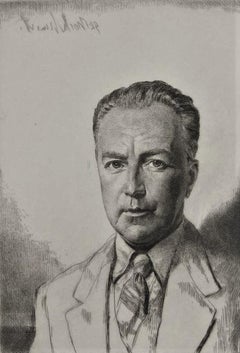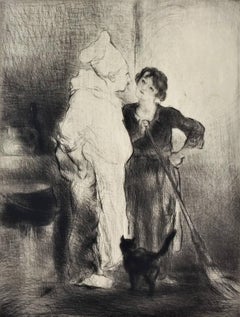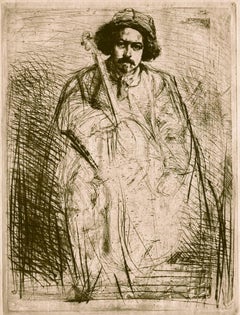Want more images or videos?
Request additional images or videos from the seller
1 of 9
Gerald Leslie BrockhurstDorette (Kathleen Nancy Woodward).1942
1942
Price:$6,000
About the Item
- Creator:Gerald Leslie Brockhurst (1890 - 1978, English)
- Creation Year:1942
- Dimensions:Height: 19.5 in (49.53 cm)Width: 15 in (38.1 cm)Depth: 1 in (2.54 cm)
- Medium:
- Movement & Style:
- Period:
- Condition:
- Gallery Location:Storrs, CT
- Reference Number:1stDibs: LU33526961592
Gerald Leslie Brockhurst
(b Birmingham, 31 Oct. 1890; d Franklin Lakes, NJ, 4 May 1978). British-born painter and etcher who became an American citizen in 1949. Precociously gifted, an excellent draughtsman, and a fine craftsman, Brockhurst won several prizes at the Royal Academy Schools and went on to have a highly successful career as a society portraitist, first in Britain and then in the USA, where he settled in 1939, working in New York and New Jersey. He is best known for his portraits of glamorous women, painted in an eye-catching, dramatically lit, formally posed style similar to that later associated with Annigoni. As an etcher Brockhurst is remembered particularly for Adolescence (1932), a powerful study of a naked girl on the verge of womanhood staring broodingly into a mirror—one of the masterpieces of 20th-century printmaking.
About the Seller
5.0
Recognized Seller
These prestigious sellers are industry leaders and represent the highest echelon for item quality and design.
Established in 1977
1stDibs seller since 2016
725 sales on 1stDibs
Associations
International Fine Print Dealers Association
Authenticity Guarantee
In the unlikely event there’s an issue with an item’s authenticity, contact us within 1 year for a full refund. DetailsMoney-Back Guarantee
If your item is not as described, is damaged in transit, or does not arrive, contact us within 7 days for a full refund. Details24-Hour Cancellation
You have a 24-hour grace period in which to reconsider your purchase, with no questions asked.Vetted Professional Sellers
Our world-class sellers must adhere to strict standards for service and quality, maintaining the integrity of our listings.Price-Match Guarantee
If you find that a seller listed the same item for a lower price elsewhere, we’ll match it.Trusted Global Delivery
Our best-in-class carrier network provides specialized shipping options worldwide, including custom delivery.You May Also Like
Salvador Dali - La Fontaine Portrait - Handsigned Engraving
By Salvador Dalí
Located in Collonge Bellerive, Geneve, CH
Salvador Dali - La Fontaine Portrait - Handsigned Engraving
1974
Hand signed by Dali
Edition: /250
The dimensions of the image are 22.8 x 15.7 inches on 31 x 23.2 inch paper
Referenc...
Category
1970s Surrealist Figurative Prints
Materials
Drypoint, Aquatint
$2,991
H 29.93 in W 22.84 in D 0.04 in
Man Holding Hat
By Isabel Bishop
Located in Middletown, NY
New York: Sylvan Cole, 1929.
Etching on white wove Rives paper with an infinity watermark, 5 15/16 x 3 15/16 inches (151 x 100 mm); sheet 15 7/16 x 11 15/16 inches (392 x 303 mm), f...
Category
1920s American Realist Portrait Prints
Materials
Drypoint, Aquatint
The Fish Market
Located in Middletown, NY
Etching with drypoint and aquatint on laid Japon paper, 9 x 11 1/4 inches (228 x 280 mm); sheet 11 7/8 x 13 5/8 (302 x 346 mm), full margins. Signed, titled and inscribed "To my dear...
Category
Mid-20th Century American Realist Portrait Prints
Materials
Aquatint, Drypoint
My Daughter
Located in Middletown, NY
Drypoint etching on buff wove paper, 9 3/4 x 12 3/4 inches (250 x 322 mm), full margins. Signed in pencil, lower right margin. Some general age tone, and minor mat tone around the pe...
Category
Early 20th Century Modern Portrait Prints
Materials
Drypoint, Etching
Sniggling for Eel
By Douglas Gorsline
Located in Middletown, NY
Etching with drypoint in black ink on antique laid paper with various large watermarks, 6 3/4 x 5 3/8 inches (172 x 132 mm), full margins with deckle edges on two sides. Signed, date...
Category
Mid-20th Century American Realist Portrait Prints
Materials
Laid Paper, Drypoint, Etching
Fourteenth Street Oriental
By Isabel Bishop
Located in Middletown, NY
New York: Associated American Artists, 1950. Drypoint and aquatint on white wove paper, 5 7/8 x 3 15/16 inches (150 x 100 mm), full margins. Signed in pencil in the lower margin. Pri...
Category
Mid-20th Century American Realist Portrait Prints
Materials
Drypoint, Aquatint
René de Laudonnière Sablais (de Burdigale). After Crispjin van de Passe I
By Charles Meryon
Located in Middletown, NY
Paris: 1861
Etching, drypoint, and engraving on cream laid paper, 6 x 4 1/4 inches (152 x 108 mm), full margins. Dog-eared left corner, extending 3-inches into the sheet, but well ou...
Category
Mid-19th Century French School Portrait Prints
Materials
Laid Paper, Engraving, Drypoint, Etching
Vieille Masken, La Servante Anversoise
By Félicien Rops
Located in Middletown, NY
Etching with engraving and drypoint printed in brownish black ink on cream laid paper with a partial heraldic A and fleur-de-lis watermark, 5 5/8 x 4 1/4 inches ( 341 x 107 mm), full...
Category
Late 19th Century French School Portrait Prints
Materials
Laid Paper, Engraving, Drypoint, Etching
14th Street Oriental
By Isabel Bishop
Located in Middletown, NY
New York, Associated American Artists, 1950. Drypoint and aquatint on cream wove paper, 5 7/8 x 3 15/16 inches (150 x 100 mm), full margins. Signed and numbered 48/50 in pencil, lower margin. Printed by Stephen Sholinsky...
Category
Mid-20th Century American Modern Portrait Prints
Materials
Drypoint, Aquatint
The Spectacle Seller
By Adriaen Jansz van Ostade
Located in Middletown, NY
Etching and drypoint on cream laid paper, 4 x 3 3/8 inches (102 x 86 mm), 1/4 inch margins. Signed in the plate, lower left corner. The 3rd state (of 6), after the rounding of the pl...
Category
Mid-17th Century Old Masters Figurative Prints
Materials
Drypoint, Laid Paper, Etching
More From This Seller
View AllPortrait of James McBey.
By Walter Tittle
Located in Storrs, CT
James McBey. 1931. Drypoint. 8 7/8 x 5 7/8 (sheet 11 1/2 x 9 ). An extremely rich impression with drypoint burr, printed by the artist on cream wove paper. Signed in the plate lower ...
Category
1930s American Modern Portrait Prints
Materials
Drypoint, Etching
Olliver St. John Gogarty
By Gerald Leslie Brockhurst
Located in Storrs, CT
Oliver St. John Gogarty. 1935. Etching. Fletcher 78. 6 7/8 x 5 1/2 (sheet 11 1/4 x 8 3/8). Edition 100. 75 intended for the Cuala Press, Dublin. A rich impression, printed on cream-wove paper. Signed in pencil.
The etching was done as a commission for Cuala Press, Dublin, as a frontispiece for Gogarty's book, Elbow Room Before publication, the project was changed and the print was never used.
Oliver Joseph St. John Gogarty (17 August 1878 – 22 September 1957) was an Irish poet...
Category
Mid-20th Century Modern Portrait Prints
Materials
Drypoint, Etching
Below Stairs.
By Edmund Blampied
Located in Storrs, CT
Below Stairs. 1930-31. Drypoint. Appleby 143. 10 1/4 x 7 3/4 (sheet 15 3/4 x 10 1/8). Edition 100, #31. A very rich, tonal impression on cream-colored laid paper. Unobtrusive soiling in the top left- and lower-left hand margins, just below the platemark; and light mat line just outside the platemark. . Signed and numbered in ink. Housed in a 20 x 16-inch archival mat, suitable for framing. A charming discussion between the chef and a scullery maid in a "Downtown Abbey...
Category
1930s Modern Figurative Prints
Materials
Drypoint, Etching
$975 Sale Price
56% Off
Becquet
By James Abbott McNeill Whistler
Located in Storrs, CT
J. Becquet, Sculptor (The Fiddler). 1859. Drypoint. Kennedy 52 state iv; Glasgow 62. state i. 10 1/8 x 7 1/2 (sheet 15 5/16 x 9 3/4). Series: "Sixteen Etchings or Scenes on the Thame...
Category
Mid-19th Century American Impressionist Figurative Prints
Materials
Drypoint, Etching
Wheelbarrow Race
By Edmund Blampied
Located in Storrs, CT
1925-26. Drypoint. Appleby 114. 8 9/16 x 12 (sheet 12 x 17). Edition 100, #10. An excellent impression with burr, printed with plate tone on the full sheet of 'VGI' laid paper with ...
Category
1920s Modern Figurative Prints
Materials
Drypoint, Etching
En Pension.
By Edmund Blampied
Located in Storrs, CT
En Pension. 1929-30. Drypoint. Appleby 142. 8 1/2 x 12 1/8 (sheet 11 1/2 x 18 5/16). Edition 100. A rich impression printed on cream wove paper with wide margins. Signed in ink. H...
Category
1920s Modern Figurative Prints
Materials
Drypoint, Etching
Recently Viewed
View AllMore Ways To Browse
Antique Fox Terrier
Art Deco Horse Painting
Chestnut Horse Painting
Craig Green
Cubist Cat
Dachshund Painting
Diana Princess Of Wales
Flying Birds Paintings
Gorilla Painting
Halsman Dali
Horse Painting David
Hunt Slonem Ascension
Hunt Slonem Red Bunny
Israeli Women
Italian Dog Paintings
James Kent
Jellyfish Painting
John Gielgud
